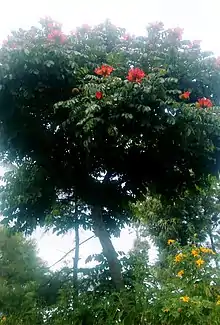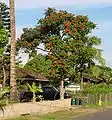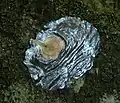| Spathodea | |
|---|---|
 | |
_2.jpg.webp) | |
| Scientific classification | |
| Kingdom: | Plantae |
| Clade: | Tracheophytes |
| Clade: | Angiosperms |
| Clade: | Eudicots |
| Clade: | Asterids |
| Order: | Lamiales |
| Family: | Bignoniaceae |
| Clade: | Crescentiina |
| Clade: | Paleotropical clade |
| Genus: | Spathodea P.Beauv. |
| Species: | S. campanulata |
| Binomial name | |
| Spathodea campanulata | |
Spathodea is a genus in the plant family Bignoniaceae. The single species it contains, Spathodea campanulata, is commonly known as the African tulip tree.[2] The tree grows between 7–25 m (23–82 ft) tall and is native to tropical dry forests of Africa. It has been nominated as among 100 of the "World's Worst" invaders.[3]
This tree is planted extensively as an ornamental tree throughout the tropics and is much appreciated for its very showy reddish-orange or crimson (rarely yellow), campanulate flowers. The generic name comes from the Ancient Greek words σπαθη (spathe) and οιδα (oida),[4] referring to the spathe-like calyx.[5] It was identified by Europeans in 1787 on the Gold Coast of Africa.[6]
Description

The flower bud is ampule-shaped and contains water. People sometimes play with these buds because of their ability to squirt water.[7] The sap sometimes stains yellow on fingers and clothes. The open flowers are cup-shaped and hold rain and dew, making them attractive to many species of birds.
Flower anatomy
The African tulip tree flower produces large flamboyant reddish-orange flowers that have approximately five petals and are 8-15 cm long. The flowers are bisexual and zygomorphic. These are displayed in a terminal corymb-like raceme inflorescence. Its pedicel is approximately 6 cm long. This flower also has a yellow margin and throat. The pistil can be found at center of four stamens that is inserted on the corolla tube. This flower has a slender ovary that is superior and is two celled. The seeds of this tree are flat, thin, and broadly winged.
Species associations
In Neotropical gardens and parks, their nectar is popular with many hummingbirds, such as the black-throated mango (Anthracothorax nigricollis), the black jacobin (Florisuga fusca), or the gilded hummingbird (Hylocharis chrysura).[8] The wood of the tree is soft and is used for nesting by many hole-building birds such as barbets. [9] Unfortunately the flowers have a natural defence killing bees, and it is thought various other species who harvest its pollen.
Geographic distribution
- Native to: Angola, Ethiopia, Ghana, Kenya, Sudan, Tanzania, Uganda, Zambia
- Exotic in: Australia, Bangladesh,[10]Brazil, Colombia, Costa Rica, Cuba, Fiji, Hawaii, India, Jamaica, Mauritius, Mexico, Papua New Guinea, Puerto Rico, Sri Lanka, Zanzibar, Philippines
It has become an invasive species in many tropical areas, such as Hawaii, Queensland (Australia), Fiji, Papua New Guinea, South Africa[11] and the wet and intermediate zones of Sri Lanka.[12]
Spathodea campanulata is a declared class 3 pest species in Queensland, Australia, under the Land Protection (Pest and Stock Route Management) Act 2002.[13] It is known to be toxic to Australian native stingless bees, such as Lipotriches (Austronomia) flavoviridis.[14]
Pests and diseases
In Uganda, two lepidopteran species, two termite species, and one bark beetle attack S. campanulata. In Puerto Rico nine insect species in the orders Hemiptera, Hymenoptera, Lepidoptera, and Thysanoptera have been reported as feeding on various parts of S. campanulata. The species is quite susceptible to butt and heart rot; wood of the tree rots quickly when in contact with the ground.
Use
Its wood is too weak for construction use but ideal enough for boxes and toothpicks. Fijian children sometimes use its flower buds as water pistols.[15]
Common names
- Afrikaans: fakkelboom, Afrika-vlamboom
- Bangla: rudrapalash (রুদ্রপলাশ)
- English: African tulip tree, fountain tree, Nandi flame, Nile flame, squirt tree, tulip tree, Uganda flame, Flame Tree of Thika
- Fijian: pasiu, pisipisi[15]
- French: immortel étranger
- Hindi: rugtoora (रुग्तूरा)
- Indonesian: Kiacret
- Kannada: Neerukayi mara, Jeerkolavi mara (ನೀರುಕಾಯಿ ಮರ, ಜೀರ್ಕೊೞವಿ ಮರ, ಜೀರ್ಕೊಳವಿ ಮರ)
- Luganda: kifabakazi
- Luhya: muzurio
- Malay: panchut-panchut
- Malayalam: African Poomaram (ആഫ്രിക്കൻ പൂമരം)
- Sinhala: kudaella gaha, kudulu
- Spanish: amapola, espatodea, mampolo, tulipán africano, in Puerto Rico meaíto, in Guatemala llama del bosque.
- Swahili: kibobakasi, kifabakazi
- Telugu: Neeti Budda (నీటి బుడ్డ), Gonuganta (గోనుగంట)
- Tamil: pasadi (பாசடி)
Nandi: Septet (singular),Septonok (plural)
- Trade name: Nandi flame
Gallery
_flower_in_Narshapur%252C_AP_W_IMG_0721.jpg.webp) Flower
Flower_at_Secunderabad_W_IMG_6626.jpg.webp) Fruit
Fruit Bark
Bark Habitus
Habitus Buds
Buds Seed
Seed Yellow cultivar
Yellow cultivar Buds
Buds Fruits
Fruits Fruits
Fruits Phyllotaxy
Phyllotaxy Leaves
Leaves
Footnotes
- ↑ Rivers, M.C. & Mark, J. (2017). "Spathodea campanulata". IUCN Red List of Threatened Species. 2017: e.T49196213A49196223. Retrieved 13 November 2023.
- ↑ USDA, NRCS (n.d.). "Spathodea campanulata". The PLANTS Database (plants.usda.gov). Greensboro, North Carolina: National Plant Data Team. Retrieved 24 November 2015.
- ↑ "GISD".
- ↑ Gledhill, D. (2008). The Names of Plants (4 ed.). Cambridge University Press. p. 357. ISBN 978-0-521-86645-3.
- ↑ Quattrocchi, Umberto (2000). CRC World Dictionary of Plant Names. Vol. 4 R-Z. Taylor & Francis US. p. 2526. ISBN 978-0-8493-2678-3.
- ↑ African Tulip Tropical Tree
- ↑ Hargreaves, Dorothy; Hargreaves, Bob (1964). Tropical Trees of Hawaii. Kailua, Hawaii: Hargreaves. p. 2. ISBN 9780910690027.
- ↑ Baza Mendonça & dos Anjos (2005)
- ↑ de QUEIROZ, A. C. M., VENTURIERI, G., VENTURIERI, G., & de OLIVEIRA JUNIOR, M. C. M. (2012). Effect of toxicity of nectar and pollen of african tulip tree (Spathodea campanulata) on Melipona fasciculata and M. seminigra (Apidae, Meliponini). In Embrapa Amazônia Oriental-Resumo em anais de congresso (ALICE). In: ENCONTRO SOBRE ABELHAS, 10., 2012, Ribeirão Preto. Anais... Ribeirão Preto: FUNPEC, 2012
- ↑ "ফুটেছে রুদ্রপলাশ | প্রথম আলো". 18 April 2018.
- ↑ "African tulip tree – Invasive Species South Africa". Retrieved 2022-02-17.
- ↑ Invasive Species Compendium and Lalith Gunasekera, Invasive Plants: A guide to the identification of the most invasive plants of Sri Lanka, Colombo 2009, pp. 70–71.
- ↑ Land Protection (Pest and Stock Route) Regulation 2003 (Qld) - Schedule 2
- ↑ O'Flaherty, Antonia (2021-02-17). "Brisbane beekeeper creates editable map to track African tulip trees killing native stingless bees". ABC News. Australian Broadcasting Corporation. Retrieved 2021-02-18.
- 1 2 Keppel, Gunnar; Ghazanfar, Shahina A. (2011). Trees of Fiji: A Guide to 100 Rainforest Trees (third, revised ed.). Secretariat of the Pacific Community & Deutsche Gesellschaft für Technische Zusammenarbeit. pp. 58–9.
References
- Baza Mendonça, Luciana & dos Anjos, Luiz (2005): Beija-flores (Aves, Trochilidae) e seus recursos florais em uma área urbana do Sul do Brasil [Hummingbirds (Aves, Trochilidae) and their flowers in an urban area of southern Brazil]. [Portuguese with English abstract] Revista Brasileira de Zoologia 22(1): 51–59. doi:10.1590/S0101-81752005000100007 PDF fulltext
- http://www.issg.org/database/species/ecology.asp?si=75
External links
 Data related to Spathodea campanulata at Wikispecies
Data related to Spathodea campanulata at Wikispecies Media related to Spathodea at Wikimedia Commons
Media related to Spathodea at Wikimedia Commons
